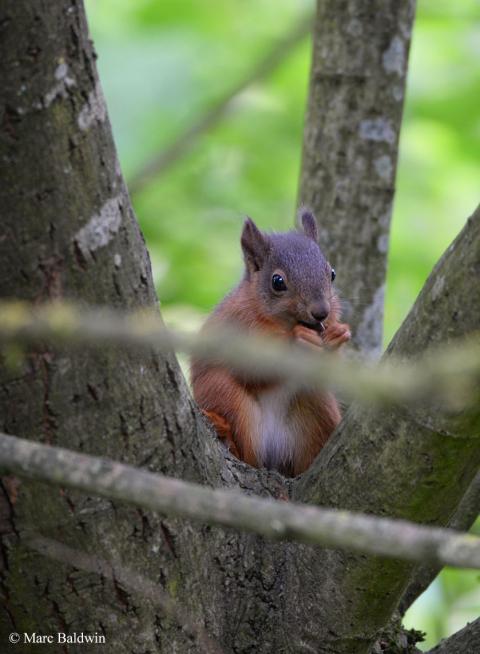Squirrel Behaviour - Dispersal
Excluding during significant food shortages, squirrels aren’t migratory, but their movements and dispersal is closely linked with seed crop and, for males, the availability and distribution of sexually-active females. In her 1987 Whittet book, Squirrels, Jessica Holm noted how Red squirrels will make exploratory trips outside of their normal home range, particularly during poor seed years, but this is not dispersal as these trips are temporary.

Dispersal is the process by which animals move from one area and setup a home range somewhere else. In The Eurasian Red Squirrel, Stefan Bosch and Peter Lurz note that, in stable habitats with a dependable food supply, dispersal is usually a juvenile phenomenon, with newly-independent animals leaving their mother’s home range to look for their own territory; but that adults will also disperse and compete with juveniles for new settlement areas in habitats that experience large-scale fluctuations or cycles in tree seed crops, such as spruce plantations.
In one study, published in 1995, Luc Wauters and his colleagues found that, of 44 adult female Red squirrels living in a pine forest in Belgium, only seven (16%) moved from the territories on which they first settled. Once established, females appear to stay on a territory for life, if conditions allow, and did not actively bequeath their territory to their offspring. Autumn is the peak season for Red squirrel dispersal although, during good mast years, spring-born kittens may disperse during the summer months.
As with Red squirrels, Greys also tend to disperse during the autumn, although spring-born kittens may disperse during summer and some populations show their peak dispersal during June. Tracking studies have demonstrated that Grey dispersal is often preceded by a period of about three months during which the animals move over a larger area, suggesting food resources are low. Between 1986 and 1990, John Koprowski trapped and uniquely marked 151 Grey squirrels, 80 males and 71 females, and followed their movements around the campus of the University of Kansus.
In a paper to the Journal of Mammalogy during 1996, Koprowski described how both sexes were more prone to dispersing than staying on their natal area, but females were more likely to hang around than males. Of 43 females that Koprowski captured as juveniles, 16 (37%) remained on their natal range, while only two (6%) of the 34 males stayed and, in both cases, this was because their mothers died shortly after they were weaned. Twelve of the 16 females that stayed on their natal range mated and eight produced at least one litter in the territory, suggesting that they were not simply delaying dispersal. Koprowski was able to document 900 interactions between marked adult squirrels during his study and found that females remaining in their natal range appear to form kinship groups, because neighbouring animals are likely to be close relatives, that are more tolerant of each other than they are of strangers or distant relatives.
As with most mammals, squirrels appear to undergo an “exploration phase” shortly prior to dispersal, at between two and six months old, during which they expand their home range area considerably as they look for other suitable locations. High densities of females in surrounding areas appears to impede settlement success of females from both species and the presence of Greys may reduce the settlement success of Reds.
The trigger for dispersal isn't well understood, but several observations related to me by members of the public who have been watching dreys in their gardens suggests that the female essentially just takes off one day when she's “had enough”, and this inspires the kittens to disperse soon afterwards. The female may then return, a week or so later, to reclaim the drey. These are, however, unsubstantiated observations and, to the best of my knowledge, this remains a poorly studied area of squirrel natural history in both species.